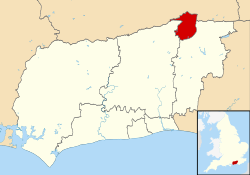Our website is made possible by displaying online advertisements to our visitors.
Please consider supporting us by disabling your ad blocker.
Crawley
Crawley | |
|---|---|
| Borough of Crawley | |
The High Street, Queen's Square, Goff's Park House and the Memorial Gardens with the centre in the background | |
| Motto(s): "I Grow and I Rejoice" | |
| Coordinates: 51°6′33″N 0°11′14″W / 51.10917°N 0.18722°W | |
| Sovereign state | United Kingdom |
| Constituent country | England |
| Region | South East England |
| Ceremonial county | West Sussex |
| Historic county | Sussex (Town centre and outlying areas) Surrey (Gatwick Airport) |
| Admin HQ | Crawley Town Hall |
| Founded | 5th century |
| Town charter | 1202 |
| Borough status | 1974 |
| Government | |
| • Type | Borough |
| • Body | Crawley Borough Council |
| • Leadership | Leader and cabinet |
| • Council Leader | Cllr Michael Jones (L) |
| • Mayor | Cllr Sharmila Sivarajah (L) |
| • MPs | Peter Lamb (L) |
| Area | |
• Borough | 17.36 sq mi (44.96 km2) |
| Elevation | 260 ft (80 m) |
| Population (2022) | |
• Borough | 119,509 (ranked 200th) |
| • Density | 5,750/sq mi (2,221/km2) |
| Ethnicity (2021) | |
| • Ethnic groups | |
| Religion (2021) | |
| • Religion | List
|
| Time zone | UTC+0 (Greenwich Mean Time) |
| Postcode | |
| Area code | 01293 |
| ISO 3166-2 | GB-WSX (West Sussex) |
| ONS code | 45UE (ONS) E07000226 (GSS) |
| OS grid reference | TQ268360 |
| NUTS 3 | UKJ24 |
| Website | crawley |
Crawley (ⓘ) is a town and borough in West Sussex, England. It is 28 miles (45 km) south of London, 18 miles (29 km) north of Brighton and Hove, and 32 miles (51 km) north-east of the county town of Chichester. Crawley covers an area of 17.36 square miles (44.96 km2) and had a population of 118,493 at the time of the 2021 Census. Southern parts of the borough lie immediately next to the High Weald National Landscape.
The area has been inhabited since the Stone Age,[2] and was a centre of ironworking in the Iron Age and Roman times. The area was probably used by the kings of Sussex for hunting.[3] Initially a clearing in the vast forest of the Weald, Crawley began as a settlement on the boundary of two of the sub-regions particular to Sussex, known as Rapes, the Rape of Bramber and the Rape of Lewes. Becoming a market town in 1202, Crawley developed slowly, serving the surrounding villages in the Weald. In the medieval period, its location on the main road from London to the port of Shoreham helped the town to grow and when Brighton became a fashionable seaside town in the 17th century this brought passing trade, which encouraged the development of coaching inns. A rail link to London and Brighton opened in 1841, encouraged further development.
After the Second World War, the British Government planned to move large numbers of people and jobs out of London and into new towns around South East England. The New Towns Act 1946 (9 & 10 Geo. 6. c. 68) designated Crawley as the site of one of these.[4] A master plan was developed for the establishment of new residential, commercial, industrial and civic areas, and rapid development greatly increased the size and population of the town over a few decades.
The town expanded further in 1974, to include Gatwick Airport, Britain's 2nd busiest international airport and in 2024, the 10th largest in Europe. The town contains 14 residential neighbourhoods radiating out from the core of the old market town, and separated by main roads and railway lines. The nearby communities of Ifield, Pound Hill and Three Bridges were absorbed into the new town at various stages in its development. Established in 2019, the south-western suburb of Kilnwood Vale lies outside of the borough boundary in the neighbouring district of Horsham. [5]
Economically, the town has developed into the main centre of industry and employment between London and the coast at Brighton. Its large industrial area supports manufacturing and service companies, many of them connected with the airport. The commercial and retail sectors continue to expand.[4]
In the late 20th century and early 21st century, the town has attracted a diverse and multicultural population. It is home to about two-thirds of the UK's population of Chagossians.[6]
- ^ a b UK Census (2021). "2021 Census Area Profile – Crawley Local Authority (E07000226)". Nomis. Office for National Statistics. Retrieved 5 January 2024.
- ^ Gwynne 1990, p. 9.
- ^ 'The Kent and Sussex Weald, Peter Brandon, published by Phillimore and Company, 2003 ISBN 1-86077-241-2
- ^ a b "Select Committee on Transport, Local Government and the Regions: Appendices to the Minutes of Evidence. Supplementary memorandum by Crawley Borough Council (NT 15(a))". United Kingdom Parliament Publications and Records website. The Information Policy Division, Office of Public Sector Information. 2002. Archived from the original on 17 July 2019. Retrieved 2 April 2008.
- ^ "West and North West of Crawley". Horsham District Council & Crawley Borough Council. 2006–2009. Archived from the original on 6 December 2007. Retrieved 29 October 2009.
- ^ "Forced into exile: the Chagossians scattered in Mauritius and Britain". The Guardian. 7 October 2024. Retrieved 4 February 2025.
Previous Page Next Page








